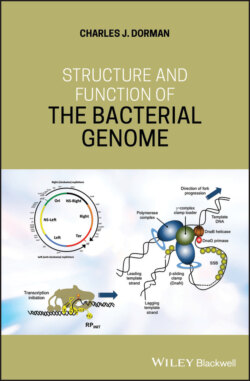Читать книгу Structure and Function of the Bacterial Genome - Charles J. Dorman - Страница 56
1.45 H‐NSB/Hfp and H‐NS2: H‐NS Homologues of HGT Origin
ОглавлениеGenes encoding proteins related to H‐NS are found in pathogenicity islands that have been acquired by HGT. Hfp/H‐NSB is an H‐NS‐like protein that is expressed by a gene in the serU pathogenicity island in the chromosome of uropathogenic E. coli (Müller et al. 2010; Williams and Free 2005). It can form heterodimers with H‐NS and may modulate its activity in helping UPEC to adapt to environmental conditions encountered during the infection process (Dorman 2010; Müller et al. 2010). The H‐NSB/Hfp protein is also encoded by a chromosomal island in E. carotovora but is absent from an island in enteropathogenic E. coli (EPEC) that is closely related to the serU island of UPEC (Williams and Free 2005). This association of a gene encoding an H‐NS‐like protein with a former mobile genetic element is reminiscent of similar associations with elements that are currently mobile such as self‐transmissible plasmids and bacteriophage (Section 1.44). The absence of the hnsB gene from the version of the serU island that is present in EPEC is intriguing, given that hnsB is both present and expressed in the corresponding island in UPEC. Perhaps the gene had performed its role once the EPEC island was established in the chromosome and it was subsequently lost in the absence of a selective pressure to keep it? If so, the different environmental circumstances experienced by EPEC and UPEC seem to have selected for retention of hnsB by the latter organism.
Enteroaggregative E. coli (EAEC) strains express, in addition to H‐NS and StpA, an H‐NS2 protein that is closely related to H‐NS. H‐NS2 behaves somewhat like H‐NS when the latter is in a complex with Hha: it targets A+T‐rich genes that have been acquired by HGT and silences them transcriptionally (Prieto et al. 2018). The amino acid sequence of H‐NS2 is similar to those of H‐NSB and Hfp, but differs from them in a number of respects. It does not exhibit the sensitivity to proteolytic turnover that is a characteristic of these H‐NS homologues and StpA (Prieto et al. 2018). It is possible, and plausible, that H‐NS2 and other ‘third homologues’ could form heteromeric complexes with H‐NS or StpA that have distinct activities from those of the homodimers. Certainly, H‐NS heterodimers with StpA have properties that are distinct from those of the homodimers (Johansson et al. 2001; Leonard et al. 2009), so expanding the number of interacting partners may represent a way of modulating NAP function (Beloin et al. ; Sonden and Uhlin 1996; Zhang et al. 1996).
